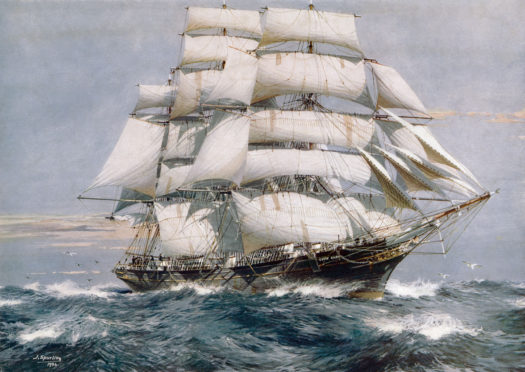
The Cutty Sark celebrated its 150th birthday last week.
The fastest and only surviving tea clipper, it is today preserved for posterity at a dry dock in Greenwich.
Louise Macfarlane, curator since May 2016, tells Murray Scougall the Honest Truth about the Clyde-built ship
When and where was the Cutty Sark built?
Cutty Sark was built in Dumbarton, Scotland in 1869. The ship was launched on November 22, 1869.
Who built the ship?
John “Jock” Willis commissioned relative unknowns to build the ship that would become Cutty Sark. Scott & Linton had only built one ship before and yet they were entrusted to build a vessel vying to be the fastest afloat. They rented the Woodyard from William Denny & Bros at Dumbarton and began work in February 1869. Jock Willis, a shrewd businessman, recognisable by the white top hat he liked to wear around town, negotiated a relatively low price for Cutty Sark, so much so that Scott & Linton were bankrupted in the process.
How much did it cost to build?
The agreed price was £16,150, or £17 per ton. The going rate was around £21 per ton.
What was the purpose of the Cutty Sark?
It was built exclusively for the China tea trade. There was a fashion for drinking the first and supposedly freshest tea back to London. This meant that it paid to be the fastest. Clipper ships – the name comes from the phrase “to go at a clip” – had three main design characteristics: a long, narrow hull; a sharp extended bow and three raking masts which could support a huge sail area. These three elements in combination could make the most of the wind to help the ship surge through the seas.
What the origin of the name Cutty Sark?
It comes from the Robert Burns poem Tam O Shanter. Farmer Tam, encounters a coven of witches. Among them is the beautiful, young witch called Nannie who wears a short and revealing nightdress or “cutty sark”.
Realising they are being spied upon, Nannie gives chase. Tam manages to escape by heading for running water, which witches cannot cross, but not before Nannie has ripped the tail from Tam’s poor horse Maggie. An angry looking Nannie, in her short nightdress became Cutty Sark’s figurehead. Built, designed and owned by Scots, the ship has a proud Scottish heritage and so a link to Robert Burns seems fitting. But it seems a strange phrase to have selected, particularly considering the inability to cross running water. We know that racehorses were named “Cutty Sark” before the ship was built and that the vessel was built the year after it’s great competitor, Thermopylae. So it would seem the name is all about speed and giving chase.
How fast was the Cutty Sark?
Cutty Sark’s top speed was 17.5knots, roughly 20 miles per hour.
Why is the ship so famous?
In Cutty Sark’s career, the ship was the fastest afloat. Today, Cutty Sark is the sole, surviving tea clipper ship that once surged through the waves in the world.
Where did it sail to?
Over the course of her 52-year career, including 27 years as a Portuguese ship Ferreira, the clipper has visited almost every major international port in the world.
Who was the captain?
Cutty Sark had seven captains as a British ship. The ship’s longest serving and most successful was Captain Richard Woodget who served between 1885 and 1895.
Did the ship ever get into trouble?
Yes, Cutty Sark lost her rudder at least twice, collided with other ships, survived a hurricane, dismasting, two world wars and a terrible fire in 2007.
Where is she now?
Berthed in a specially built dry-dock in Greenwich. The ship has been lifted three metres from the ground. It’s possible to walk beneath the ship and marvel at the shape that helped Cutty Sark to be so fast.

Enjoy the convenience of having The Sunday Post delivered as a digital ePaper straight to your smartphone, tablet or computer.
Subscribe for only £5.49 a month and enjoy all the benefits of the printed paper as a digital replica.
Subscribe